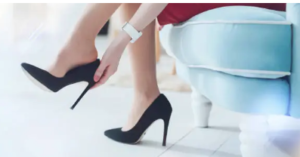Women love the best selling high heels because they look elegant, and the height of the heel can give a “perk” to a woman’s lower back area (tastefully called her derriere). However, high heels can also be difficult to walk in and can cause painful foot conditions.
To help prevent these problems, try on a wide range of heels in the shoe store to find a pair that fits comfortably without pinching or rubbing.
- Look for Comfort
 High heels are an indispensable part of a woman’s wardrobe, but they can also cause pain if they are not chosen carefully. To avoid painful feet, look for a heel that is lightweight and made from high-quality material. Heels that are made from real leather or suede tend to adjust better to the shape of your foot and are less likely to chafe.
High heels are an indispensable part of a woman’s wardrobe, but they can also cause pain if they are not chosen carefully. To avoid painful feet, look for a heel that is lightweight and made from high-quality material. Heels that are made from real leather or suede tend to adjust better to the shape of your foot and are less likely to chafe.
The height of the heel also matters when it comes to comfort. Heels that are too high can put more strain on your knees, back, and ankles. Instead, opt for a heel that is between 3 cm to 9 cm tall. It will give you enough height to be fashionable but will still be easy to walk in.
- Think About the Environment
High heels may never go out of style with true fashionistas, but they aren’t without their downsides. Heels can cause a variety of foot conditions, from minor problems like bunions and corns to more serious issues such as arthritis and back pain. Luckily, there are ways to minimize the negative impact of wearing high heels.
- Think About Your Shoes’ Shape
When shopping for a high heel, it’s important to consider the shape of the shoe. If the shoes are too narrow, your feet will get crushed, and this will lead to blisters and pain. If the shoes are too wide, your feet will slip around in them, and they won’t be secure on your feet. It can lead to discomfort, and they will also be harder to walk in.
When trying on shoes, it’s best to do so after you’ve walked a bit and your feet are slightly swollen. It is when they are most sensitive and will give you a better idea of whether the shoes fit well or not. Look for a wide-toe box and make sure that your longest toe is not touching the edge of the shoe. You should also be able to move your toes a bit in the shoe without too much friction or looseness.
- Don’t Forget About Your Feet
With 26 bones, 33 joints and 100 muscles, ligaments and tendons, our feet are complex and essential to our balance, support and posture. Putting your feet in high heels for long periods can lead to imbalances, poor posture and short-term or chronic foot problems.
A good rule of thumb is to wear high heels no more than half of the time, and the rest of the time should be spent either barefoot or in supportive flat-soled shoes like walking or running shoes. If you must wear high heels, try saving them for special occasions and be sure to buy a pair with a heel that is as short as possible.
High heels put all the weight on the ball of the foot. It can cause the toes to become shortened and the small muscles in the foot to weaken over time. It can lead to painful bunions, hammertoes and calluses.
When buying a pair of the best selling high heels, always walk in them and parade up and down the shop floor to see how they feel. Also, remember that your feet will swell throughout the day, so choose a pair of heels that have a little room in the toe box, and make sure they fit well (go up a size if you need to). Shoes that are too tight will cause the toes to cramp and blister.
